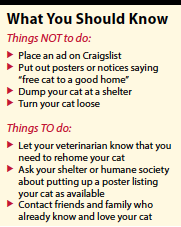Adopting a cat comes with the plan of keeping that feline family member forever. But sometimes circumstances beyond anyone’s control intervene, and a cat becomes in need of a new home.
Do not feel guilty about such an unfortunate decision. Instead, turn your sadness into a determination to find your cat a good new home. If the home placement is urgent, contact your local animal shelters and your veterinarian. You never know when one of them may know of a cat lover looking for just the right companion. If not, you can set about this challenge fully armed.
If possible, start looking at rehoming possibilities before you need to place your cat. If you start early enough, you will have more time to evaluate potential new families and explore all possible options. You don’t have to turn the cat over immediately, but you can put the pieces in place in case that day arrives.
Reasons For Rehoming
Finances are a big reason people are sometimes forced to give up their pets. A local shelter or some humane societies may be able to help with food and veterinary care costs until you get back on your feet. It is to their benefit—and the cat’s—to try to keep her in your home rather than having her in a shelter.
If you’re trying to escape domestic violence, you do not need to leave your cat. Many domestic-violence shelters accommodate pets. And, never stay in an abusive home for your cat’s sake.
Another common reason for a pet needing to be rehomed is to relieve stress among other pets or people in your home. While it is painful to do so, the relief after you’ve made the move can be a sign that you made the right decision.
Planning
While putting the word out, prepare your cat’s “resume.” Collect copies of her veterinary records and include important papers like microchip registration so these can be transferred. If you got your cat from a breeder, contact the breeder. Many reputable breeders will take back cats they provided.
Start a notebook with your cat’s preferences for food, litter, toys, and types of play. Mention her idiosyncrasies, like if she loves to play with balls of aluminum foil and will retrieve them, for example. Consider whether she is good with children, dogs, and other cats. Be honest. If your cat truly hates dogs and will puff up and hiss, or attack or go into hiding for 24 hours when confronted by a dog, it is best that she goes to a home without dogs.
Some cats won’t adjust to being indoor-only cats. For these cats, reaching out to local barns and farms to see if anyone needs a barn cat can be a great option. Follow all the same procedures for screening, of course, but living in a barn cat situation might make your cat very comfortable in her new home.
Screening New Owners
Be prepared to invest time in evaluating potential new homes. If the person has cats already or has had cats, ask for their veterinarian’s info to check for a recommendation. Ask for three other references and contact the references. Check with local animal-control and area shelters to see if they have had any less-than-ideal experiences with the person.
Ask to visit the person’s home. Does it look cat-friendly? If there are other pets, do they look well cared for? Try to determine whether all household members are on board with adding a new cat. If your cat has “people preferences” such as hating toddlers, a new home where the family babysits grandbabies for three days a week may not be a good choice for your cat.
A Trial Period
If you’re proactive in your search, you can set up a trial period for your cat and her new family. Many cats take time to adapt to a new home and family. Ideally, you can set up a trial period so both your cat and the new family can see if this is truly a good match. Two or three weeks minimum is best. It may take your cat that long to adjust and stop hiding.
Send food along and include some feline pheromones such as Feliway. If catnip mellows her out, pack some catnip. Any of her usual items or favorite toys can help make the new place feel like home. Think about her beloved window seat, a comfy bed she chooses every night, or a favorite scratching post, which can help make the adjustment easier.
 Hopefully, the new home can arrange for any current pets to meet your cat slowly and safely. Sniffing under a door, then greeting through a pet gate are good options. If there is a “neutral territory” room in the house, that is best for face-to-face intros.
Hopefully, the new home can arrange for any current pets to meet your cat slowly and safely. Sniffing under a door, then greeting through a pet gate are good options. If there is a “neutral territory” room in the house, that is best for face-to-face intros.
Make sure the new owner knows that you will help if there are problems, including taking the cat back. This is a big reason why handling this before your absolute “cat must leave” deadline is best. You may have to try more than once to find the right match.
Having to rehome a beloved cat can mean heartbreak for you. For the sake of you and your cat, take the time needed to find a suitable situation for her.




